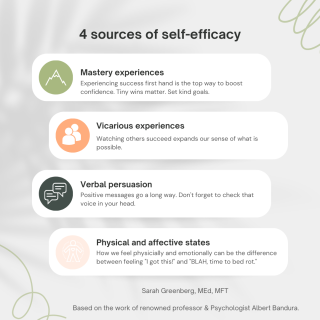Confidence
Cracking the Secret to Genuine Confidence
Seven ways to build genuine confidence at any age.
Updated July 18, 2023 Reviewed by Monica Vilhauer Ph.D.
“She believed she could, so she did.” —R.S. Grey
“Confidence is power” is one of those oft-used phrases that sounds true, but doesn’t actually tell us anything about how to achieve that confidence. To many, confidence, like power, feels both highly desirable and highly out of reach.
Feeling at a loss, many rely on strategies such as “fake it until you make it,” which aren’t entirely ineffective, but also don’t provide a very robust map for how to actually build confidence.
One of my favorite parts about studying psychology is that it contains all of these maps that feel like “secrets” to a better life. They aren’t perfect, but they are highly illuminating, shining light on new possibilities. In this blog, I’ll give a high-level view of some of the “secrets” therapists know about how to help you build self-confidence, no matter your starting point or your age.
First, Let’s Unpack the Word Confidence
If you visit a therapist and tell them “I’m here because I want to be more confident,” their likely response will be “Tell me more…” or “What do you mean by confidence?”
That’s because the term confidence is a colloquial term that can mean different things to different people. And it’s hard to strategically grow “something” if you don’t know what that “something” is.
While confidence feels general, sweeping across almost any arena of life, positive growth generally works best when the goal is more defined and specific.
Often, what someone means by confidence, when further unpacked, is similar to the term “self-efficacy.”
Self-efficacy is a concept first introduced by the influential Canadian-American psychologist Albert Bandura in 1977. Self-efficacy means an individual’s belief in their capacity to achieve a given goal.
A lack of self-efficacy creates a vicious cycle of not believing in oneself, not trying, not succeeding (because how can you succeed without trying?), and not believing in oneself again.

How Confidence Is Built
Sometimes we see someone who seems so self-assured, it’s hard to imagine they weren’t born that way. But I can assure you that like most skills in life, confidence isn’t given, it is formed. Do some early childhoods and life histories set someone up for higher confidence? Of course. We are all products of our environments. Yet, our brains, all the way until we breathe our last breath, have plasticity and are capable of forming new growth and pathways at any time. In other words, you can build your confidence at any point in your life span.
A key to building self-efficacy or self-confidence is understanding where it comes from. According to Bandura, self-efficacy has four sources:
- Experiencing success first hand: What Bandura calls “mastery experiences” simply means first hand experience of success. If you imagine someone learning how to ride a bike, few start out feeling confident. And if they do, the confidence cracks with that first fall. But with a series of small successes, staying upright a few seconds, doing the first turn, the confidence grows.
- Seeing others experience success: As social animals, we learn in the context of relationships and by watching others. This is what Bandura, also the father of social learning theory, calls “vicarious experiences.” Continuing with the example of learning to ride a bike, this might look like watching one’s older siblings or friends ride around. Seeing others who you find relatable doing what you want to do enhances your sense that this is something that can be done, and something that you can do.
- Positive messages: This is what Bandura refers to as “verbal persuasion.” You can imagine a child or adult learning to ride a bike surrounded by others who believe in them. “You can do it,” a small crowd cheers, “You’ve done hard things before!” The positive verbal persuasion can come from others, or from oneself.
- Physical and emotional states: The fourth source of self-efficacy is “physical and affective states.” Imagine you set out to learn bike riding just after receiving an “F” on a math test, or when you are starting to get a flu. We’ve all experienced how feeling crappy on a given day can shift our sense of confidence, just as we’ve all experienced how some days we feel more ready than ever to conquer goals. Confidence isn’t fixed—it waxes and wanes with how we feel emotionally and physically.
7 Steps to Building Confidence in a Specific Part of Your Life
Now that you know how self-efficacy is built, you can choose how you want to go about growing your own confidence. Mastery experiences, research shows, tend to be the most impactful approach. Yet, all of these are valuable sources of confidence. Choose one area of life, ideally an area that is within your control, and start intentionally building your confidence step-by-step. Here are some starting points.
- Start with tiny, achievable goals in the right direction. One small step in the right direction builds your sense of success and can serve as an engine moving you toward the next step. Over time, these tiny steps add up towards big gains.
- Recall success experiences. The human mind has a natural negativity bias, meaning we're likely to put more weight on the negative. So, when facing a challenge, it's helpful to intentionally remind yourself of the times you have succeeded, especially the times you succeeded even when you thought you couldn't.
- Identify role models who have achieved what you seek. Make sure they are relatable. For example, if I want to improve my cooking, I'm better off looking to a friend a few steps ahead of me, versus a celebrity chef 100 steps ahead with an entire hidden crew supporting their work.
- Surround yourself with positive messages by paying attention to those who boost your sense of “I can do this."
- Don't forget to watch that inner voice. Pay attention to that inner dialogue that is with you always. When you catch yourself naysaying yourself, try talking to yourself like you would your best friend.
- Set yourself up for success. Remember self-efficacy and self-confidence are states that can ebb and flow. When you feel well rested, physically strong, and in alignment with your values, you are also more likely to believe, "Yes I can." Think of the specific actions you take toward a goal as a seed, and the rest of your habits and environment as the soil. Don't forget to tend the soil.
- Let go of perfection. Genuine confidence isn't about believing you can be the most perfect at any task. It's about believing you can make intentional progress toward goals you find most meaningful. Set your goals with an attitude of self-kindness.
References
Bandura A. (1977). Self-efficacy: toward a unifying theory of behavioral change. Psychology Review. 84, 191–215. 10.1037/0033-295X.84.2.191
Bandura A. (2001). Social cognitive theory: an agentic perspective. Annual Review of Psychology. 52, 1–26. 10.1146/annurev.psych.52.1.1


